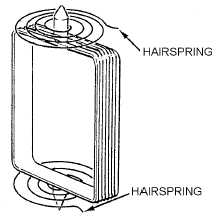1-8
To use this permanent-magnet moving-coil device as a meter, two problems must be solved. First, a
way must be found to return the coil to its original position when there is no current through the coil.
Second, a method is needed to indicate the amount of coil movement.
The first problem is solved by the use of hairsprings attached to each end of the coil as shown in
figure 1-7. These hairsprings can also be used to make the electrical connections to the coil. With the use
of hairsprings, the coil will return to its initial position when there is no current. The springs will also tend
to resist the movement of the coil when there is current through the coil. When the attraction between the
magnetic fields (from the permanent magnet and the coil) is exactly equal to the force of the hairsprings,
the coil will stop moving toward the magnet.
Figure 1-7.—Coil and hairsprings.
As the current through the coil increases, the magnetic field generated around the coil increases. The
stronger the magnetic field around the coil, the farther the coil will move. This is a good basis for a meter.
But, how will you know how far the coil moves? If a pointer is attached to the coil and extended out
to a scale, the pointer will move as the coil moves, and the scale can be marked to indicate the amount of
current through the coil. This is shown in figure 1-8.
Figure 1-8.—A complete coil.
Two other features are used to increase the accuracy and efficiency of this meter movement. First, an
iron core is placed inside the coil to concentrate the magnetic fields. Second, curved pole pieces are



